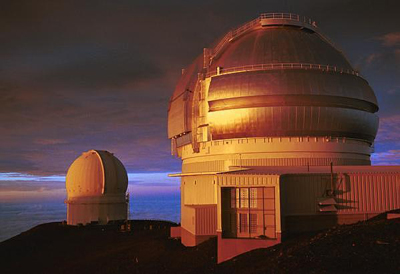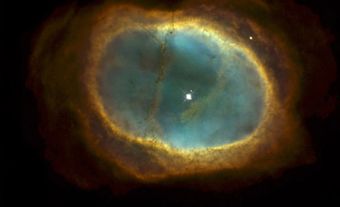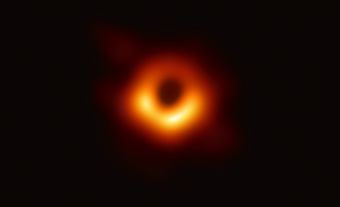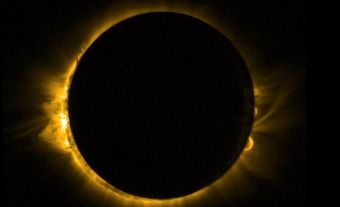Astronomy is the science that studies the sun, the solar system, the remote stars, distant galaxies and all other detectable bodies in the universe. Its major subdisciplines include astrophysics, the closely related field of spectroscopy and cosmology. Astronomy is often regarded as the oldest science. For more than 5,000 years, motions in the sky have been used to predict events such as the annual flood of the Nile River. During the era of modern exploration, astronomy had practical applications in navigation, surveying and timekeeping.
Modern astronomy, however, is more concerned with the physical and chemical nature of matter beyond Earth, where conditions of temperature, pressure and gravitational and magnetic fields allow astronomers to observe matter under extremes unattainable in terrestrial laboratories. Astronomy is also closely related to physics, chemistry, mathematics, geology, engineering and computer science.

History in Canada
The earliest astronomical observations in what is now Canada were scattered observations made as early as 1612 by Arctic explorers and occasional sightings of comets and eclipses recorded by French missionaries as early as 1618. Jesuit missionaries recorded an eclipse on 27 October 1632. Depending on the definition adopted, there may be some disagreement about the earliest astronomical observatory. One of the earliest observatories in North America was built by the Marquis de Chabert in 1750-51 at Louisbourg. Chabert produced maps and astronomical observations as well as a report, Voyage fait par ordre du Roi en 1750 et 1751 dans l'Amerique septentrionale. Unfortunately, nothing remains of this observatory.
There is evidence that Joseph Frederick Wallet DesBarres built a small observatory in 1765 at Castle Frederick, Nova Scotia, to test his surveying instruments. The building probably also housed astronomical telescopes. Nothing remains of this structure. The Toronto Magnetic Observatory began observations in 1840, but the astronomical instruments intended for it were never received. In 1850, an observatory was constructed on the Citadel in Quebec City to support the requirements of marine navigation. Still, neither the original structure nor its successor, built on the Plains of Abraham in 1874, survives today.
An astronomical observatory was built in 1851 on the University of New Brunswick campus, and an official plaque, unveiled in 1955, identifies this building as the "First Astronomical Observatory in Canada." (See also Observatory.) A public observatory was built in Kingston in 1856; an observatory for time determination followed in Montreal in 1862; and modest telescopes were erected in other towns and cities in the next three decades. The federal government became involved in 1885 because of the urgent need to survey lands adjacent to the transcontinental railway since astronomical techniques were required in mountainous regions.
The determination of longitude (relative to the meridian of a city in Western Europe) for a ship at sea, a recently discovered island or a colony in the Americas was a major problem during the voyages of discovery. The invention and perfection of the marine chronometer by John Harrison in 1761 solved the practical problem. Before this, however, various astronomical methods were used in attempts to determine longitude: in New France, the Jesuits and others had observed more than a dozen eclipses between 1632 and 1694; five lunar eclipses were observed at Quebec City or at Ste Marie Among the Hurons ( Midland, Ontario) that were also observed in Europe, and some useful longitudes were derived. Although some solar eclipses were observed quite well, the theory of the time was inadequate to derive accurate longitudes from the observations.
By the 19th century, interest in eclipses had shifted from determining longitudes to studying the sun; therefore, total solar eclipses became events of interest. Eclipse expeditions involve careful planning and frequently difficult journeys to remote locations, such as that made by an American expedition to northern Manitoba to observe the total eclipse of 17 July 1860. The party, which included Simon Newcomb, an American astronomer born in Nova Scotia, suffered the fate common to later expeditions: clouds on the crucial day. The 20th century has produced eight total solar eclipses in Canada, which have been studied by ground parties and, since 1945, from aircraft and even rockets. The most significant Canadian expedition, however, remains the one led by Clarence Augustus Chant to Australia in 1922, during which observations were made of the displacement of stars near the eclipsed sun. These measurements helped provide observational support for the theory of relativity.
Few stories in the history of astronomy can rival those associated with early observations of the transits of Venus. On the rare occasions when Venus is directly between Earth and the sun, it is seen to cross the solar disc over the course of several hours. It was realized in the 17th century that accurate timing of such transits (which come in pairs, eight years apart, once every 122 years) could be used to establish the solar system's scale. Immense efforts were made to observe the transit of 1769, including an arduous expedition to the area of Churchill, Manitoba, by the astronomer William Wales and another English observer, Joseph Dymond. After a frightening winter, they made successful observations of the transit.
An attempted observation from Île aux Coudres, 100 km downstream from Quebec City, was incomplete because of clouds. In 1882, there were plans to observe the transit from more settled areas of Canada, including substantial observatories in Woodstock, Ontario (which was clouded out at crucial times) and Kingston, Ontario (where useful observations were made). These international campaigns were moderately successful, but observational problems limited the accuracy of the final result.
Did you know?
On 8 April 2024, a total solar eclipse passed over some of the most populated areas of Mexico, the United Stated, and Canada. Southern Ontario, Southern Quebec, and much of the Atlantic provinces witnessed this historic solar eclipse.

Observatories in Canada
Canadian astronomy shows a pattern of parallel development in universities and federal government agencies. The provinces have been involved indirectly through their general support of university development. The federal government made its first provision for astrophysical research by establishing the Dominion Observatory in Ottawa (1905). This facility was equipped with a refracting telescope, a reflecting solar telescope, and transit instruments for positional astronomy. (See also Observatory.) Government research facilities expanded in 1918 when the Dominion Astrophysical Observatory was opened near Victoria, British Columbia. Its 1.88 m (72-inch) telescope was the world's largest at its installation (1918). Facilities at Victoria have been upgraded with a second telescope and continuous modernization of detecting equipment.
Major radio observatories have been built near Penticton, British Columbia, and in Algonquin Provincial Park, Ontario. In recent years, the most important instrument for Canadian optical astronomers has been the Canada-France-Hawaii Telescope on Mauna Kea in Hawaii, which opened in 1979. In 1970, all government astronomical research programs were placed under the aegis of the National Research Council (NRC). The NRC's Herzberg Institute of Astrophysics was formed in 1975, adding laboratory astrophysics and space science programs.

Education
The first Canadian Department of Astronomy was established at the University of Toronto in 1904, and in 1933, through the efforts of Clarence Augustus Chant, the university acquired the David Dunlap Observatory. In 1971, the University of Toronto inaugurated the first Canadian telescope in the Southern Hemisphere at Las Campanas, Chile. Early in 1987, a Canadian astronomer, Ian Shelton, discovered a supernova outburst in the Large Magellanic Cloud with this telescope, a major astronomical event with far-reaching implications in astronomical research. Western University, Queen's University, York University, University of Calgary, University of Alberta and University of Victoria also have observatory facilities. The Université de Montréal and Laval share facilities at Mont Mégantic, Quebec.
Undergraduate training is only available from the following universities: McGill, Laval, Lethbridge, Manitoba, Saskatchewan and Simon Fraser. The universities of Alberta, British Columbia, Guelph, Montreal, Queen's, Saint Mary's, Toronto, Victoria, Waterloo, Western Ontario and York offer both undergraduate and graduate training.
The first major planetarium in Canada was the Queen Elizabeth II Planetarium, which opened in Edmonton in 1962. Several cities in Canada now have planetariums that offer public visual instruction in astronomy for a moderate fee.
Canadian Astronomers
Despite its small size, the Canadian astronomical community has included many eminent scientists renowned for their contributions to international astronomy, among the most prominent being Carlyle Smith Beals, Sidney Van den Bergh, Clarence Augustus Chant, Arthur Covington, J. Donald Fernie, William Edmund Harper, Frank Scott Hogg, Helen Battles Hogg-Priestley, William Lyon Mackenzie King, John Lambourne Locke, Donald C. Morton, Andrew McKellar, Peter Millman, Joseph Algernon Pearce, R.M. Robert Methven Petrie, John Stanley Plaskett, Robert Meldrum Stewart and Reynold Kenneth Young.

Societies and Journals
Active astronomical societies, the members of which are professional astronomers or amateur enthusiasts, flourish today at local, national and international levels. The earliest Canadian astronomical society was the Toronto Astronomical Club, formed in 1868 through the initiative of Andrew Elvins. The club was an outgrowth of the Canadian Institute and, after two decades of variable vitality, became the Astronomical and Physical Society of Toronto in 1890. The name was changed to the Royal Astronomical Society of Canada (RASC) in 1903, and local centres have joined until, at present, there are 20 centres in major cities across Canada. The membership of nearly 3,000 includes both professional and nonprofessional members.
Each centre operates its own lecture program, and many have constructed fine observing facilities. An annual general assembly attracts members from throughout Canada and abroad for a 3-day meeting held in different parts of the country to exchange ideas and reports on achievements. Not all local astronomy clubs are part of the RASC. Several autonomous clubs exist in various cities and towns and French-language clubs are associated in Quebec, l'Association des groupes d'astronomes amateurs (AGAA). More than a dozen clubs belong to the AGAA, including the two French-speaking centres of the RASC; the total membership is about 1000.
The Canadian Astronomical Society (CAS) was formed in 1970 as the society of professional astronomers in Canada and has nearly 602 members. The society conducts an annual meeting to present research results and to represent astronomers in matters of national concern.
Astronomical papers appeared as early as the 1850s in The Canadian Journal, published by the Canadian Institute. The first Transactions of the Astronomical and Physical Society of Toronto were published in 1891; this annual publication was superseded by the Journal of the Royal Astronomical Society of Canada in 1907. The journal has published at least six issues per year since then. The periodical is designed to interest both amateurs and professionals and has a substantial circulation abroad. The society also publishes the Observer's Handbook annually, a compendium of forthcoming sky events and astronomical data. The RASC, many of its individual centres, the AGAA, the CAS and other clubs also publish newsletters on a regular basis.

 Share on Facebook
Share on Facebook Share on X
Share on X Share by Email
Share by Email Share on Google Classroom
Share on Google Classroom



